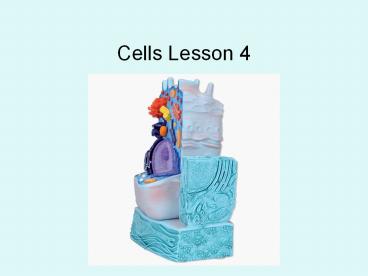Cells Lesson 4 - PowerPoint PPT Presentation
1 / 14
Title:
Cells Lesson 4
Description:
Cells Lesson 4 How can we prove that cells exist if we can t see them? In your table groups you have got 2 minutes to discuss your ideas and then we will talk about ... – PowerPoint PPT presentation
Number of Views:166
Avg rating:3.0/5.0
Title: Cells Lesson 4
1
Cells Lesson 4
2
How can we prove that cells exist if we cant see
them?
Use your scientific thinking
In your table groups you have got 2 minutes to
discuss your ideas and then we will talk about
them as a class
Make sure you listen to everyone in your group
3
Learning intentions
- At the end of this lesson
- All will have
- used a microscope safely and effectively and
produced a labelled diagram of an animal cell and
a model aniaml cell. - Most will have
- peer-assessed a labelled diagram of an animal
cell and be able to recall the functions of parts
of an animal cell, - completed the crossword
- Some will have
- demonstrated their understanding by completing
Microscopes, size and scale.
4
Responsible use of microscopes
- Microscopes are fragile and delicate
- They should always be carried with two hands one
underneath and one holding the curved part of the
body. - You should not touch the lenses.
- Persistent mistakes include
- holding the microscope with one hand
- focussing down onto the slide and breaking it
- turning the objective lens around and crashing
into the slide - forgetting to mop up excess liquid.
5
How to use a microscope
- Now follow the instructions below carefully.
- Make sure you have selected the low power
objective lens (its the smallest). - Look down the eyepiece and adjust the mirror
until it is as light as you can get it. - Move the focussing knob until the objective lens
is as far down as it will go. - Put your slide on the stage and secure it with
the stage clips. - Using the focussing knob, move the objective lens
slowly up. Until you can see something. (You
will need to keep looking down the eyepiece as
you do this). - When you think you can see something, check with
the teacher before drawing what you see. - When you have finished, remember to remove the
slide from the microscope before packing it away.
6
How are we going to look at an animal cell?
7
Remember the rules?
8
Recording what you can see
Things outlined in black are probably air
bubbles! Get me to help you if you cant see!
9
- Write a clear heading.
- Use a sharp HB pencil.
- Draw firm, continuous lines and avoid using too
much shading. - Include the magnification.
- Draw label lines with a ruler. These must not
touch the structure they are labelling and should
not cross each other. - Write labels horizontally on the page (pupils
often write along the same angle as the label
lines) and arrange them neatly around (not over)
the drawing.
10
Recording what you can see
11
What do all the parts do?
What do the organelles do?
Contain chlorophyll where photosynthesis happens
Controls what happens in the cell (contains DNA)
- Nucleus
- Cell membrane
- Cytoplasm
- Chloroplast
- Cell wall
- Vacuole
Contains cell sap keeps the cell firm
Jelly-like substance where reactions happen
Made of cellulose and supports the cell
Keeps substances in the cell and controls what
goes in and out
12
(No Transcript)
13
Complete the activity
- Microscopes, size and scale.
- This activity will help develop your thinking
skills.
14
Objective lens
Nucleus
Eye piece
Coarse focus
Cell membrane
Light
Cytoplasm
Slide
Stage
Fine focus































